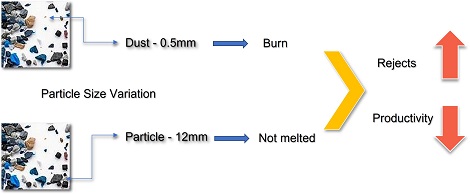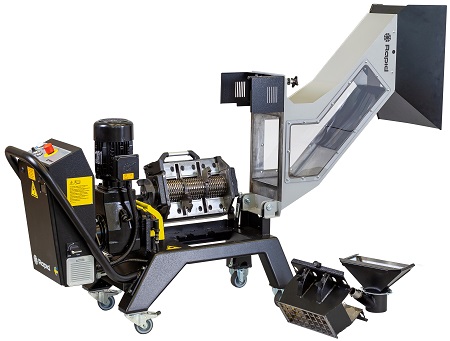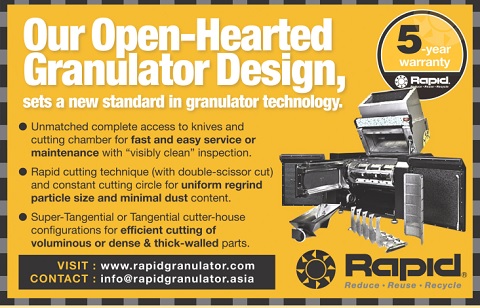With today's upward spiral of resin prices, it makes economic sense to maximise the resin you have. One common way to do that is with regrind. Regrind is reclaimed and repurposed excess material and reject parts from the process, which can be mixed with new resin or used on its own.
Given that thermoplastics are capable of being heated and re-shaped many times, regrind appears to be an obvious solution to improve operational efficiency by repurposing process waste. However, care must be taken to ensure that the use of regrind does not significantly impact either the process or the product quality. To determine the possibility to use regrind the following factors must be considered:
How much regrind to use?
The amount of regrind allowed and used depends on the part produced and the process itself. While it can be 100% with some products, in others (e.g. medical applications) it can be none. Generally, the industry targets 20-25% for blending regrind into virgin resin.
Optimal mix of regrind will be influenced by factors such as calibration of the virgin and regrind feeders. While some blenders are sophisticated, incorrect calibrations and hopper geometry (angle of repose) can result in hang-up or bridging. Virgin resin, regrind and additives must also be mixed properly to avoid inconsistency in the mix.
Excessive regrind can get you in trouble too. Some resins such as nylon, PET, etc, if not dried properly before initial processing will cause significant degrading of the polymer. This degradation is not visible to the naked eye. Produced parts may look good but will have lower physical or chemical properties which can lead to costly part failures. Blending regrind of this degraded quality into virgin at levels more than optimal may result in such issues.

Regrind granule size
When rejected parts go through a granulator there is potential to get a wide range of granule sizes from fines and dust to 12mm or larger chunks. During plasticising, these different sized granules will not melt homogeneously resulting in non-uniform melt forming the part. Further, processing is less robust due to this inconsistency.
Repelletising will eliminate this problem. Unfortunately, this will add cost to the process. For process stability, granulators should be chosen correctly and maintained well. The tighter the regrind granule size, the more efficient the process and the more time and money saved.
Excessive dust & fines in the regrind
Excessive dust and fines are often a larger problem than regrind granule size. They “burn” by melting faster while plasticising, leading to increased rejects and additional cost for inspection.
Dust and fines will also result in conveying problems such as bridging or rat-holing, which prevent material from being evacuated from the granulator discharge bin. They can also lead to build-up in the feed hopper, block the discharge and clog filters, which reduce the ability to convey material.
Dust in the air is also a health hazard in the plant and adds to housekeeping burden. Dust separators are available that specialise in the removal of fines and dust from regrind. However, they again add cost to the process and crowd the shopfloor.

Importance of having the right equipment
Adding regrind back to the process results in the ideal usage of costly raw material and lowers production costs. However, this is only true if the regrind produced is consistent enough to provide these savings. Because pellet size affects bulk density, granulation technology that improves quality and consistency of regrind size and prevents dust generation will improve processing efficiency.
Money, time and effort spent in choosing the right moulding or extrusion machine is wasted if “improper” quality of raw material is fed to these carefully chosen processing machines. They will result in lower than optimal/targeted production and higher than expected rejects. Equal importance must be given to the choice of the granulator to prevent issues, rejects and higher operational costs.
Importance of maintenance
The importance of preventive maintenance on granulators cannot be stressed enough. More than most, it is very often the condition of the granulator that has the biggest impact on the quality of the regrind. Dull knives, incorrect knife gaps and undue machine vibrations result in not only poor quality of regrind but also reduced output. It takes a relatively small amount of time and money to maintain a granulator so it can operate at maximum efficiency and produce good quality regrind.
What can be done?
Knowledge of simple granulation principles and awareness of granulation technologies that manufacturers have developed to achieve quality regrind will help select the right granulator to avoid many of the pitfalls from above:
Cutting techniques that are unique with lower cutting forces to prevent material degradation, ensure uniform regrind particle size and minimal dust generation.
Adaptive cutting chamber with different cutterhouse designs for bulky/voluminous and dense/thick-walled parts that allow for optimal gripping and cutting of part.
Constant cutting circle to maintain a constant gap between the fixed and rotating knives for efficient cutting which lowers the need for bigger motors.
Slow speed granulators that run at 30-60 rpm for hard or abrasive resins against 400-600 rpm of traditional granulators.
Fast and easy access for cleaning that involves tool-less quick access to the cutting area of the granulator. It helps reduce machine downtime and prevent contamination which eliminates the need for multiple granulators for different resins or colours.
Power assisted opening and closing of hoppers that allows for quick and easy access to the blades and the cutting area of the granulator.
Machine mount dampeners for improved stability of the granulator, reduced vibrations and lower maintenance costs.
Flywheel that allows for steady and even cutting of parts. It also helps control costly spikes in current consumption and conserve energy.
The importance of the quality of regrind can never be over emphasised. The better the regrind, the more efficient the process and more time and money saved. Maximising the utilisation of your resin through proper granulation of plastic waste is the difference between earning and losing money. Waste is cash!















